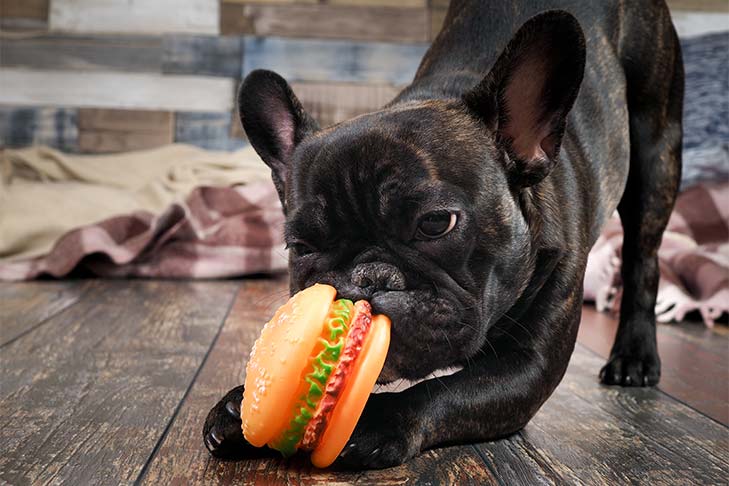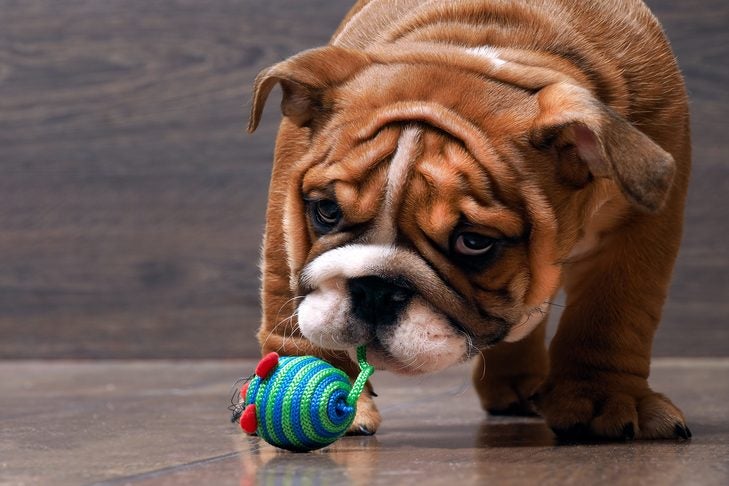AKC is a participant in affiliate advertising programs designed to provide a means for sites to earn advertising fees by advertising and linking to akc.org. If you purchase a product through this article, we may receive a portion of the sale.
Dogs find a variety of things valuable, from food to your favorite sweater. But, some might growl, stiffen, lunge, or even bite when you go near or try to retrieve something from them. Called resource guarding in dogs, this behavior is a valuable instinct for feral dogs, because it allows them to survive on limited means in the wild. But it’s not such a great trait for domesticated animals. So, how do you get your dog to stop resource guarding?
What Is Resource Guarding in Dogs?
Experienced dog owners and dog-aware people usually know not to disturb an animal while they’re eating or enjoying a toy. Simply put, you never can anticipate how they will respond. Some dogs don’t mind being petted, interrupted, or accidentally bumped into during mealtime or playtime. However, others mind such disturbances very much.

Occasionally, this behavior extends beyond food and toys. Bestselling author and animal behaviorist Patricia McConnell, Ph.D., notes that resource guarding in dogs is also known as “possessive aggression.” From a dog’s point of view, possession (like in real estate) is nine-tenths of the law. That “real estate” might range from a nesting spot to the companionship of a preferred human.
Discovering the Guarding Behavior
Chances are, you won’t know that your dog has tendencies toward resource guarding until they start exhibiting them. Nicole Costanza, AKC Canine Good Citizen Evaluator and owner of Big Momma’s Dog Training in New Jersey, says that there are body language signs to watch for when a dog is attempting to “guard” an item. Signs of resource guarding in dogs include stiffening their body over an item, a hard stare, “whale eye” (when dogs show the whites of their eyes), lifting their lips, low growling, and baring their teeth.
“Any dog can be prone to resource guarding. It’s not specific to one breed,” Costanza says. “A dog who comes from a breeder could have resource guarding issues, but a dog from the shelter may not. It all depends on the individual dog. The environment a dog grows up in could also dictate whether they have resource guarding issues or not.”
Dogs who behave like this don’t distinguish between people or animals who are going to take something away from them and anyone who’s just passing by. It only matters what they think might be a threat to their items. Dogs are responding to the trigger, not the actual action. This is one reason why resource guarding is problematic and potentially dangerous behavior in a pet.
How to Stop Your Dog From Stealing
“Your best bet is to start training early to prevent resource guarding from developing,” Costanza says. Of course, that’s not always possible, especially if you get an adult dog from a shelter or inherit one from a family member. Costanza says that you can work with dogs who resource guard their food, for example, by slowly desensitizing them to your presence around high-value items.
“Tether your dog to someplace heavy and durable. Stay 6 to 8 feet away from the dog and toss food, such as chicken or hot dogs, in the dog’s general direction,” she advises. “Walk by the dog and throw the food, but don’t stop moving. If the dog gives you warning signals like stiffening the body or a raised lip, you have wandered too close. Once you’ve done this a few times, watch to see if the dog’s body language has changed. If they look up at you in a happy way, anticipating food will be coming their way, then you may move a little closer.”

Costanza emphasizes the importance going through this process slowly and avoiding rushing the dog. The end goal is for you to be able to approach the dog’s bowl without them feeling threatened or feeling stressed. Costanza advises asking professional trainers to help deal with resource guarding in dogs, since they’ll be able to provide tips and tricks to guide you along.
Resource Guarding in Dogs: When to Ask for Help
Some dogs develop resource guarding after reaching adulthood and become unusually protective about their food, toys, and beds. Before training these dogs, it’s a good idea to take them to the vet, says Costanza. A change in behavior or a sign of aggressive behavior may indicate the presence of an underlying medical issue.
In such instances, Costanza recommends consulting either a vet or animal behaviorist to put a treatment plan into play. But that treatment isn’t always directed at the dog. People who live in the household, especially children, must learn management skills, too. It’s really important, Costanza says, to avoid engaging in any type of punishment. “No yelling at your dog, screaming at the dog, or hitting the dog to ‘exert dominance,'” she says. “This may only serve to worsen the behavior.”
Unfortunately, resource guarding, in some cases, leads to biting. If such an event occurs, Costanza strongly suggests calling in a behaviorist immediately so they can determine an outcome in an unbiased manner. This is especially important if babies or toddlers live in the home.
When left unchecked, resource guarding can become problematic, and even dangerous, behavior. Therefore, it’s important to seek professional help sooner rather than later to address the issue.

